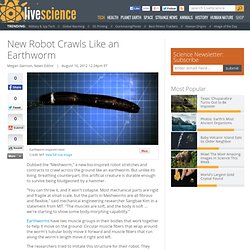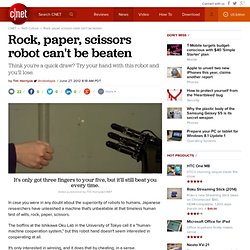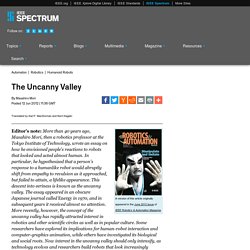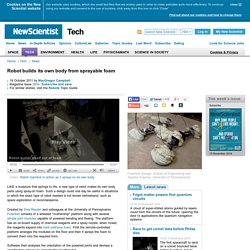

The First Drones, Used in World War I. I think they gave up on the Kettering Bug way too early.

In WWII the USN returned to the idea of "assault drones" for use against warships. As these were conceptually identical to the Japanese Kamikaze, minus the pilot, they were full aircraft and required a whole carrier deck to launch. This made it a hard sell, but it also inspired the USN to develop rocket and jet-powered alternatives that were small enough to be launched from destroyers or other aircraft, and as they say the rest is history. Self-assembling swarmbots are amazing, and look creepily alive. Robot learns to recognise itself in the mirror - tech - 22 August 2012. By Hal Hodson NICO spends a lot of time looking in the mirror.

But it’s not mere vanity – Nico is a humanoid robot that can recognise its reflection – a step on the path towards true self-awareness. In fact, Nico can identify almost exactly where its arm is in space based on the mirror image. Justin Hart and Brian Scassellati at Yale University have taught Nico to recognise the arm’s location and orientation down to accuracy of 2 centimetres in any dimension. ¿Puede un robot aprender a caminar por sí solo? One Per Cent: Genetic algorithms let Chinese drones hunt submarines. Paul Marks, senior technology correspondent MQ-8B Fire Scout Helicopter, a US ship-based UAV (Image: Martin Lee/Rex Features) Chinese navy researchers have revealed how they plan to hunt submarines using ship-launched uncrewed air vehicles (UAVs).

The plan, developed by the naval academy in Dalian, China, is to choose the best hunting pattern for a drone using the power of the genetic algorithm - a search engine that evolves an optimum solution by discarding feeble offspring and breeding the best to make ever stronger ones. The route evolved would make the best use of fuel, cater for air and sea threats and work with dropped sonar buoys. New Robot Crawls Like an Earthworm. Dubbed the "Meshworm," a new bio-inspired robot stretches and contracts to crawl across the ground like an earthworm.

But unlike its living, breathing counterpart, this artificial creature is durable enough to survive being bludgeoned by a hammer. "You can throw it, and it won't collapse. Most mechanical parts are rigid and fragile at small scale, but the parts in Meshworms are all fibrous and flexible," said mechanical engineering researcher Sangbae Kim in a statement from MIT. "The muscles are soft, and the body is soft … we're starting to show some body-morphing capability. " Earthworms have two muscle groups in their bodies that work together to help it move on the ground.
The researchers tried to imitate this structure for their robot. A small battery and circuit board was added to the tube to produce a current to heat the wires at certain segments along the body. Rock, paper, scissors robot can't be beaten. In case you were in any doubt about the superiority of robots to humans, Japanese researchers have unleashed a machine that's unbeatable at that timeless human test of wills, rock, paper, scissors.

The boffins at the Ishikawa Oku Lab in the University of Tokyo call it a "human-machine cooperation system," but this robot hand doesn't seem interested in cooperating at all. It's only interested in winning, and it does that by cheating, in a sense. A high-speed camera captures its human opponent's choice of the three weapons, and it takes only a millisecond for the robot to form the winning hand shape. As seen in the vid below, the hand looks like it's almost playing honestly and showing its weapon at the same time as the hapless human.
By the time he or she has realized what's going on, the robot has already won. Oddly enough, rock, paper, scissors is no mere child's play in Japan.
The Uncanny Valley. Translated by Karl F.

MacDorman and Norri Kageki Editor's note: More than 40 years ago, Masahiro Mori, then a robotics professor at the Tokyo Institute of Technology, wrote an essay on how he envisioned people's reactions to robots that looked and acted almost human. In particular, he hypothesized that a person's response to a humanlike robot would abruptly shift from empathy to revulsion as it approached, but failed to attain, a lifelike appearance. This descent into eeriness is known as the uncanny valley. The essay appeared in an obscure Japanese journal called Energy in 1970, and in subsequent years it received almost no attention.
Uncanny valley. In an experiment involving the human lookalike robot Repliee Q2 (pictured above), the uncovered robotic structure underneath Repliee, and the actual human who was the model for Repliee, the human lookalike triggered the highest level of mirror neuron activity.[1] Etymology[edit] The concept was identified by the robotics professor Masahiro Mori as Bukimi no Tani Genshō (不気味の谷現象) in 1970.[5][6] The term "uncanny valley" first appeared in the 1978 book Robots: Fact, Fiction, and Prediction, written by Jasia Reichardt.[7] The hypothesis has been linked to Ernst Jentsch's concept of the "uncanny" identified in a 1906 essay "On the Psychology of the Uncanny".[8][9][10] Jentsch's conception was elaborated by Sigmund Freud in a 1919 essay entitled "The Uncanny" ("Das Unheimliche").[11] Hypothesis[edit] This area of repulsive response aroused by a robot with appearance and motion between a "barely human" and "fully human" entity is called the uncanny valley.

Theoretical basis[edit] Mate selection. Facial Scare? Robots Get Human Faces: Scientific American Gallery. Most people now have computers and phones that can talk to them. From straightforward, voice-activated commands to the strangely poetic responses of the iPhone 4S's Siri, computers and humans are getting closer. Robot builds its own body from sprayable foam - tech - 19 October 2011. Video: Watch foambot in action as it sprays on its own body LIKE a sculpture that springs to life, a new type of robot makes its own body parts using spray-on foam.

Such a design could one day be useful in situations in which the exact type of robot needed is not known beforehand, such as space exploration or reconnaissance. Created by Shai Revzen and colleagues at the University of Pennsylvania Foambot consists of a wheeled "mothership" platform along with several simple joint modules capable of powered bending and flexing. Disembodied Japanese robot arms applaud your growing fear. Screen-spy program can read texts and emails - tech - 02 November 2011. Od dzisiaj latanie staje się przyjemnością. Robot cepillando a un gato con la ayuda de Kinect. Lo que vemos sobre las imágenes es el último "invento" que le ha sacado un ingeniero a Kinect.

Nao Next Gen, el robot que a muchos nos gustaría tener. Tests that show machines closing in on human abilities - tech - 22 January 2009. Read full article Continue reading page |1|2 Video: As new ways to test how well machines can match aspects of human intelligence are dreamt up, they are getting closer to beating them.

It may have been dreamt up in 1950, but the Turing test - a simple way to tell if a machine can think - still holds powerful sway over many researchers striving to produce a machine at least in some respects equal with a human. Nowadays, although UK mathematician Alan Turing's test is still relevant, and unbeaten, new forms of it have evolved. In this online special, New Scientist discovers the different ways in which machines can be tested for human-like abilities - and how close they have come to passing as one of us.
I chat, therefore I think. Robot Uses Lizard Tail to Leap [Video] Science fiction often envisions worlds populated by humanoid robots. In reality, insects, reptiles and non-human animals often serve as a more practical template for automatons. The more legs a robot has, the more easily it can navigate tough terrain. Likewise, claws are less challenging to emulate than primate-esque hands and, as a team of researchers reports this week, tails are an incredibly versatile stabilizing mechanism. Lasers power Pentagon’s next-gen artificial limbs. SExpand You mean something like this? Love that bit in Ghost in the Shell! Human Trials Next for Darpa’s Mind-Controlled Artificial Arm. Pentagon-backed scientists are getting ready to test thought-controlled prosthetic arms on human subjects, by rewiring their brains to fully integrate the artificial limbs.
Already in recent years, we’ve seen very lifelike artificial arms, monkeys nibbling bananas with mind-controlled robotic limbs and even humans whose muscle fibers have been wired to prosthetic devices. But this is the first time human brains will be opened up, implanted with a neural interface and then used to operate an artificial limb. It’s a giant step that’ll transform the devices, which were little more than hooks and cables only 50 years ago. El asombroso vuelo de un Drone casero para vigilar a policía y manifestantes.
Varsovia, 12 de noviembre del pasado sábado. A real-life swarm of flying robots, right out of a 1980s arcade game. This robotic baby crawled out of your nightmares. Here come the DNA robots. Watch robots kill each other — up close and personal! This wall-climbing robot is half tank, half gecko. Boxing Robots of the 1930s. Acrobatic Velociraptors May Inspire New Generation of Agile Droids. Meat-eating dinosaurs like Velociraptor may have been quite the acrobats, using their tails to land aerial maneuvers safely, say scientists studying today's leaping lizards. Long-tailed robots built as part of this work could help inspire a new generation of maneuverable search-and-rescue droids, the researchers add. More than 40 years ago, scientists proposed that Velociraptor and other predatory dinosaurs used their tails to stabilize their bodies during jumps or similar rapid or irregular movements, helping make them active, agile hunters.
The idea is that the raptors used their tails much as tightrope walkers use balancing poles — tightrope walkers tilt the poles to make their bodies lean in the opposite direction of the tilt, and the thought was that the extinct reptiles bent their tails to control the orientation of their bodies as they leapt. Robotic Mule Follows Soldiers Like a Huge Dog. U.S. troops who carry as much as 100 pounds of gear could soon get a robotic mule capable of shouldering their burdens in the toughest terrain. Such a robot recently showed how it can follow a person and navigate around trees and rocks while climbing a hill in its first outdoor test — but it might someday follow spoken commands like a huge, obedient dog.
The four-legged, headless "LS3" robot evolved as the quieter, faster and tougher version of Boston Dynamics' "BigDog" robot funded by the U.S. military's DARPA research arm. Upcoming trials will test the robot's ability to carry 400 pounds on a tough 20-mile trek without any refueling for 24 hours. "If successful, this could provide real value to a squad while addressing the military’s concern for unburdening troops," said Army Lt. Col. Spherical Flying Machine Developed by Japan Ministry Of Defense #DigInfo. Titanoboa meets the Mondo Spider. Meet Mask-bot, the human-like plastic head. DARPA Robot Masters Stairs. PETMAN. FastRunner, a robot Ostrich. Asimo does bottles, lovey-dovey hand gestures.
Honda's humanoid robot Asimo can now run faster, hop around, autonomously avoid people, and communicate in sign language with its new hands. In the first major update to the droid in four years, Asimo has improved AI skills, being able to operate continuously without human control, and also has better locomotion, and a remarkable 57 axes of movement. It's another step in the multimillion dollar, decades-old effort to make Asimo, first unveiled 12 years ago, useful.
It also follows criticism of Japan's robotics community for a limp response to the Fukushima nuclear crisis . Norbert Wiener. Norbert Wiener (November 26, 1894 – March 18, 1964) was an American mathematician and philosopher. He was Professor of Mathematics at MIT. A famous child prodigy, Wiener later became an early researcher in stochastic and noise processes, contributing work relevant to electronic engineering, electronic communication, and control systems.
Boids. As with most artificial life simulations, Boids is an example of emergent behavior; that is, the complexity of Boids arises from the interaction of individual agents (the boids, in this case) adhering to a set of simple rules. Boids (Flocks, Herds, and Schools: a Distributed Behavioral Model) In 1986 I made a computer model of coordinated animal motion such as bird flocks and fish schools. It was based on three dimensional computational geometry of the sort normally used in computer animation or computer aided design. Nerve probe controls cyborg moth in flight - tech - 08 February 2012. Ilb_ab09.pdf (application/pdf Objeto) Transhumanism. Transhumanism (abbreviated as H+ or h+) is an international cultural and intellectual movement with an eventual goal of fundamentally transforming the human condition by developing and making widely available technologies to greatly enhance human intellectual, physical, and psychological capacities.[1] Transhumanist thinkers study the potential benefits and dangers of emerging technologies that could overcome fundamental human limitations, as well as the ethics of developing and using such technologies.
Holy heck, these Japanese hobbyists are building a 12-foot-tall pilotable mech. Alan Kay. Semantic Web. Robert Noyce. Are Machines Dumbing Us Down? Drones Get Smarter. Drone Assassinations Hurt the U.S. More Than They Help Us. One Per Cent: Drone mission control hit by self-cloning computer virus.
The Drone Threat to National Security. Iran shows intercepted CIA drone unscathed (VIDEO) Unmanned Aerial Vehicles: coming soon to a sky near you. Video 'radar' to stop drone mid-air collisions - tech - 01 November 2011. The Drone Threat to Privacy. Remote robots: Human-free by land, sea and air - Image 1. How do modern spy planes evade detection? One Per Cent: Speed limit for birds could mean better UAVs. Rise of the Drones: Photos of Unmanned Aircraft. U.S. Drone Kills 16-Year-Old Pakistani Boy Days After He Attends Anti-Drone Organizing Meeting. AeroVironment/DARPA Nano Hummingbird UAV flying. Flight Assembled Architecture. Festo - SmartBird. X-47B robot stealth plane makes first flight.
Military Innovation Goes Way Beyond Weapons. Products / Subsea Glider / Overview.